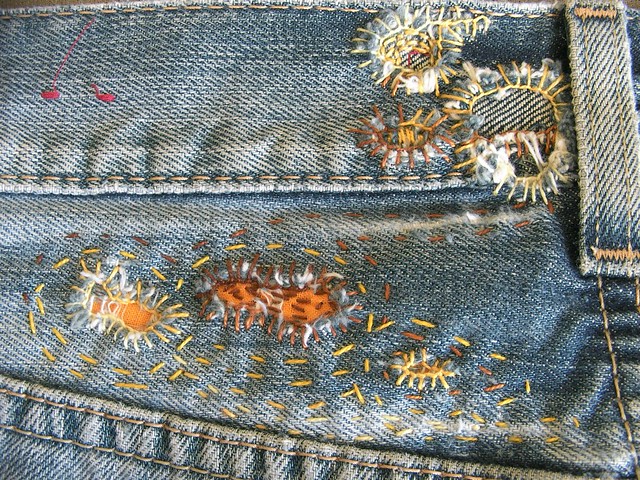faq ~ mending & binding
I got a parking ticket yesterday while doing some errands in downtown Oakland. Normally this would upset me, but all I could think is "at least I didn't have a young child who was shot and killed at school today." The school shootings in Connecticut are deeply upsetting. This senseless loss of precious young life reminds me to cherish the life I have, and all the good people who are a part of it, not to waste precious time with anger over small things like parking tickets, and to let go of fears that hold me back from fully embracing the blessings and opportunities that are in my life today.In a moment like this it feels right to pray for the people of Newtown, and to be of service to my community in all the small and large ways that I'm able. So it seems appropriate to respond to a few mending and quilting questions from readers. The first one is a mending question from Ken who sent me this image:
IMAG0421
I was searching to find out about mending to restore some of my favorite clothes. I have some Levi's jeans that need mending and a really cool vintage denim Levi's western shirt I have had since late 1980's that is really frayed at the collar. I wanted to learn to repair clothes but first was wondering if it is possible to repair a shirt's collar? Does one need a sewing machine? Your advice would be greatly appreciated. If you want I can send pictures.

No you do not need a sewing machine. Hand sewing will work just as well, but it takes more time. In my opinion, the work of the hand signifies devotion, and there is a certain amount of devotion inherent in wanting to mend a favorite shirt.
There are a several options. Try slipping the gingham fabric behind the frayed fabric and then use running stitches to hold the piece in place and a blanket stitch to secure the frayed edges as I did with the gold and orange fabrics in the image above.
OR do the same thing but without the gingham fabric, just secure the fragile areas with decorative stitching as I did on with the waistband of these jeans.
Or make a couple of long patches from the gingham, turn the edges under and pin them in place. Then appliqué the patches on top of the frayed sections. Use decorative embroidery stitches when sewing the patch in place, to make something beautifully unique out of the worn out places.
Debbie and Michelle both had questions about the binding on Negative Space:
I've been trying to figure out your finishing technique. I don't like to put bindings on my work. How do you finish yours? Could you suggest a tutorial?

I use an invisible or reverse binding on many of my quilts, especially wall hangings. I'm happy to say that I have written and posted an invisible or reverse binding tutorial right here on daintytime.net.
ps. If you have any mending or binding suggestions, please do share your tips in the comments.

